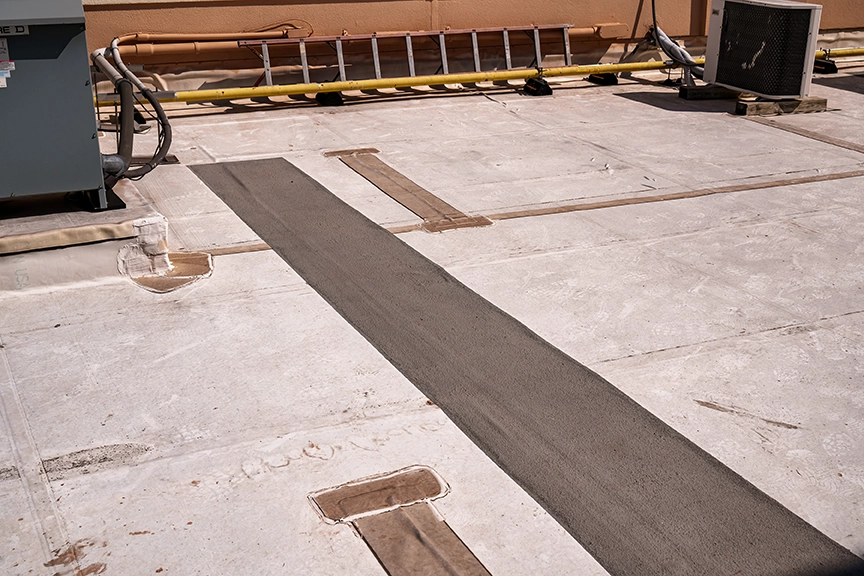How to Extend the Life of Your Flat Commercial Roof
There are many different commercial building roof types available for industrial facilities. The type you install typically depends on a few factors including climate, building use, cost, and maintenance considerations. Some of the most common commercial roof types include pitched, gable, dome, metal, built-up roofs, TPO, EPDM, and flat roofs.

Flat roofs have little to no slope and traditionally have a pitch of less than ten degrees. A commercial flat roof is a popular choice for industrial facilities because it is cost-effective, offers additional usable space, and makes it easier to install HVAC systems, solar panels, and other rooftop equipment on it.
If you have a commercial flat roof on your industrial facility, it’s critical to keep up with regular maintenance to extend the lifespan and to prevent costly repairs. Some key maintenance tips to ensure your flat roof stays in the best condition possible include the following:
Clean the Roof Regularly
Due to the design of a commercial roof, items can accumulate on top of it that you can’t see from the ground including leaves, branches, and other debris that can cause punctures, clog drainage systems, or trap moisture. Trapped moisture can result in the growth of algae and moss, which if not cleaned properly can degrade the roof material which is why it’s important to set up a maintenance schedule to clean the roof regularly.
Prevent Water Issues
Flat roofs are prone to water issues if not properly maintained. There are a few things you can do to ensure proper drainage.
- To avoid ponding, make sure water doesn’t pool on the roof because if it does, you will need to consider installing additional drainage solutions or re-grading the roof surface.
- Make certain all roof drains are clear as keeping them clear of leaves and debris will allow for proper water runoff.
- Ensure that any leaks you discover are addressed properly and promptly. To prevent emergency roof repair costs, look for water damage inside your warehouse space which can appear as water stains or mold on the walls or ceiling. If you discover any issues, repair them immediately. If not addressed promptly, small commercial roof leaks can lead to larger structural damage. It’s also important to use the appropriate patching materials and repair techniques required for your type of roof.
Maintain Structural Components
Flat roofs are comprised of many structural components that should be inspected to ensure they are functioning properly.
- The first thing you should check is the roof membrane. Examine it to see if there is any blistering as blisters or bubbles can form due to trapped air or moisture. Repair any cracks or tears you discover in the roof membrane promptly. Over time, a membrane can crack or tear due to exposure to the elements.
- Inspect your flat roof’s flashing. The metal or rubber flashing around vents, skylights, and edges should be in good condition. Replace or repair any cracked, loose, or damaged flashing to prevent water infiltration.
- Be sure to cap any roof penetrations. Ensure that areas where HVAC units, vents, and other equipment penetrate the roof are well-sealed to prevent leaks. It’s important to use the proper sealants. The condition of these sealants should also be checked regularly and replaced when they show signs of age or wear.
- Ensure your commercial structure is properly ventilated. Good ventilation will prevent condensation from building up inside the roof which can cause mold, rot, or structural damage.
Conduct Regular Inspections
Arguably, the most important thing you can do to extend the life of your flat roof is to set up a regular commercial roof maintenance plan with a reputable and experienced roofing company, such as Capital Roof Care (CRC.) We will create a maintenance plan, inspect your flat roof at least twice a year (spring and fall), and be available for on-the-spot inspections after extreme weather events, such as severe storms or heavy snowfall.
Your CRC professional may also suggest the installation of walk pads that can prevent damage from occurring when people walk on your roof’s surface. Limiting foot traffic on your roof is important because it reduces wear and tear on the roof membrane and the commercial flat roof coating.
By investing in a professional commercial roof maintenance plan, you will become aware of issues that may not be visible to an untrained eye but that can help you be aware of potential threats, minimize unexpected repair costs, and extend the life of your flat roof system. For more information about flat roofs or a commercial roof assessment, contact CRC.